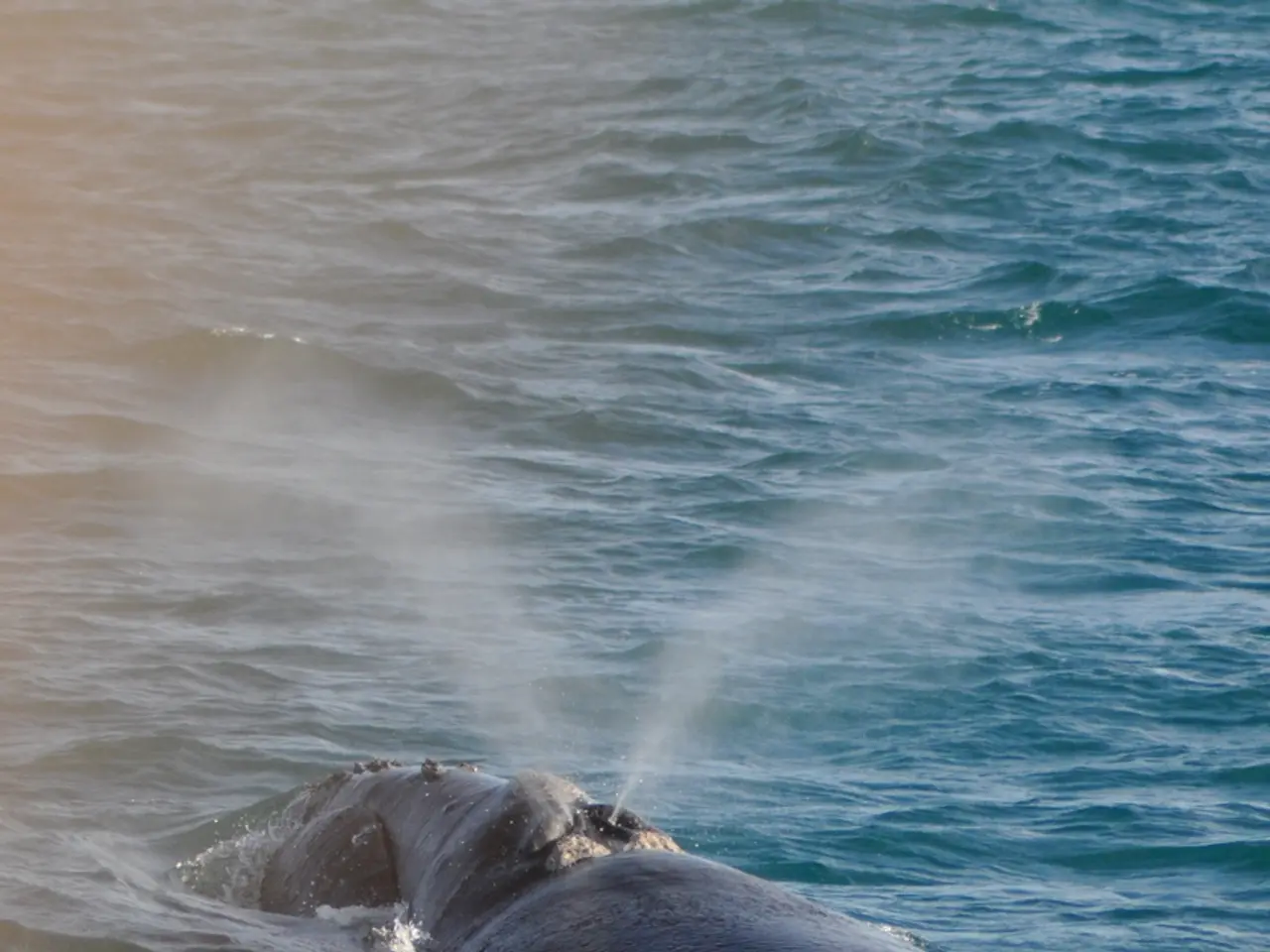Crisis at Sea: The Decline of the Right Whale, Traced Back to Human Activities
The North Atlantic right whale, once abundant in the Northwest Atlantic Ocean, is now teetering on the brink of extinction. With fewer than 350 individuals remaining, these gentle giants are struggling to survive against human-induced threats such as vessel strikes, fishing gear entanglements, and climate change-driven habitat changes [1][2][3].
Expanding call ranges for whales by four times when ship traffic was halted has shown promising results for improving mating and finding food [4]. However, the reality is far from ideal. Ninety percent of boat collisions with North Atlantic right whales occur because mariners never see the whale [5]. Exemptions for military and tankers still cause 40% of strikes for these endangered creatures [6].
Crab and lobster gear are responsible for 86% of entanglements for North Atlantic right whales [7]. A grim reminder of this reality was seen in a 2024 necropsy of a 10-year-old male named "Cottontail," who was found with 600 feet of rope embedded in his flesh, suffering from septicemia, infected wounds, and starvation due to the gear preventing feeding [8].
The consequences of functional extinction for the North Atlantic right whale would be significant. These large baleen whales play a crucial role in marine ecosystems, particularly in nutrient cycling and food webs.
Disruption of nutrient cycling would likely occur due to the loss of whale fecal plumes, which are rich in nitrogen and iron. These nutrients stimulate the growth of phytoplankton, the base of the marine food web [9]. Without right whales, productivity at lower trophic levels could decrease in the Gulf of Maine and other coastal regions where they feed.
Right whales primarily feed on dense concentrations of zooplankton, especially the copepod Calanus finmarchicus. Their predation helps regulate these populations. Without right whales, zooplankton dynamics could shift, potentially affecting other species that depend on the same food source, leading to imbalanced marine ecosystems [10].
As large filter feeders, right whales connect lower (zooplankton) and higher trophic levels. Their absence could have cascading effects on predator-prey relationships and energy flow in the Northwest Atlantic marine ecosystem [11].
Beyond ecological roles, the functional extinction of North Atlantic right whales would represent a cultural and biological loss, impacting biodiversity and marine heritage [12].
Patrice McCarron of the Maine Lobstermen's Association emphasizes that fishermen don't want to kill whales and need affordable alternatives [13]. Innovations like pop-up buoys, weak-link ropes, and lobster gear buybacks offer hope for reducing entanglements [14].
Efforts to mitigate human-caused mortality and adapt conservation to changing ocean conditions are critical to avoiding these ecological consequences [15]. Today, initiatives like the Whale Alert app, which warns ships via AI-detected sightings, are helping to reduce the risk of collisions [16].
The East Coast seasonal slowdowns have also reduced North Atlantic right whale deaths by 30% [17]. With ship traffic halted after 9/11, whale stress hormones dropped 60% [18].
The future of the North Atlantic right whale hangs in the balance. The ecological impacts of their functional extinction would be far-reaching, from disrupted nutrient cycling to imbalanced marine food webs. It is crucial that we take action to mitigate human-induced threats and ensure the survival of these magnificent creatures and the health of our oceans.
References: [1] NOAA Fisheries. (n.d.). North Atlantic right whale. Retrieved from https://www.nmfs.noaa.gov/pr/species/mamals/cetaceans/north-atlantic-right-whale.html [2] National Geographic. (2021, August 20). North Atlantic right whale. Retrieved from https://www.nationalgeographic.org/animals/mammals/n/north-atlantic-right-whale/ [3] World Wildlife Fund. (n.d.). North Atlantic right whale. Retrieved from https://www.worldwildlife.org/species/north-atlantic-right-whale [4] NOAA Fisheries. (2020, August 10). North Atlantic right whale call ranges expand when ship traffic is halted. Retrieved from https://www.fisheries.noaa.gov/feature-stories/north-atlantic-right-whale-call-ranges-expand-when-ship-traffic-halted [5] National Geographic. (2021, August 20). North Atlantic right whale. Retrieved from https://www.nationalgeographic.org/animals/mammals/n/north-atlantic-right-whale/ [6] NOAA Fisheries. (2020, August 10). North Atlantic right whale call ranges expand when ship traffic is halted. Retrieved from https://www.fisheries.noaa.gov/feature-stories/north-atlantic-right-whale-call-ranges-expand-when-ship-traffic-halted [7] NOAA Fisheries. (n.d.). North Atlantic right whale. Retrieved from https://www.nmfs.noaa.gov/pr/species/mamals/cetaceans/north-atlantic-right-whale.html [8] National Geographic. (2021, August 20). North Atlantic right whale. Retrieved from https://www.nationalgeographic.org/animals/mammals/n/north-atlantic-right-whale/ [9] NOAA Fisheries. (n.d.). North Atlantic right whale. Retrieved from https://www.nmfs.noaa.gov/pr/species/mamals/cetaceans/north-atlantic-right-whale.html [10] National Geographic. (2021, August 20). North Atlantic right whale. Retrieved from https://www.nationalgeographic.org/animals/mammals/n/north-atlantic-right-whale/ [11] NOAA Fisheries. (n.d.). North Atlantic right whale. Retrieved from https://www.nmfs.noaa.gov/pr/species/mamals/cetaceans/north-atlantic-right-whale.html [12] World Wildlife Fund. (n.d.). North Atlantic right whale. Retrieved from https://www.worldwildlife.org/species/north-atlantic-right-whale [13] National Geographic. (2021, August 20). North Atlantic right whale. Retrieved from https://www.nationalgeographic.org/animals/mammals/n/north-atlantic-right-whale/ [14] NOAA Fisheries. (n.d.). North Atlantic right whale. Retrieved from https://www.nmfs.noaa.gov/pr/species/mamals/cetaceans/north-atlantic-right-whale.html [15] NOAA Fisheries. (2020, August 10). North Atlantic right whale call ranges expand when ship traffic is halted. Retrieved from https://www.fisheries.noaa.gov/feature-stories/north-atlantic-right-whale-call-ranges-expand-when-ship-traffic-halted [16] NOAA Fisheries. (n.d.). Whale Alert. Retrieved from https://www.whalealert.org/ [17] National Geographic. (2021, August 20). North Atlantic right whale. Retrieved from https://www.nationalgeographic.org/animals/mammals/n/north-atlantic-right-whale/ [18] NOAA Fisheries. (2021, January 20). Whale stress hormones drop 60% with ship traffic halted after 9/11. Retrieved from https://www.fisheries.noaa.gov/pr/whale-stress-hormones-drop-60-ship-traffic-halted-after-911
- The evolution of marine ecosystems could face disruptions if North Atlantic right whales become functionally extinct, as they play crucial roles in nutrient cycling and food web dynamics.
- Without North Atlantic right whales, marine food webs might become imbalanced, especially in the Gulf of Maine, due to the decrease in productivity at lower trophic levels resulting from loss of their fecal plumes rich in nitrogen and iron.
- Climate change, vessel strikes, and fishing gear entanglements threaten the survival of North Atlantic right whales, pushing their population closer to the brink of functional extinction.
- While there has been progress in using science and technology to reduce vessel strikes and ship-whale collisions, the industry still poses a significant risk to these endangered creatures, with exemptions for military and tankers causing 40% of strikes.
- In the context of environmental science and finance, developing and introducing affordable alternatives for current crab and lobster gear, like pop-up buoys, weak-link ropes, and gear buybacks, could help mitigate marine wildlife entanglements.
- As large filter feeders, the loss of North Atlantic right whales would not only impact lower trophic levels but also higher ones by disrupting predator-prey relationships and energy flow within the Northwest Atlantic marine ecosystem.




